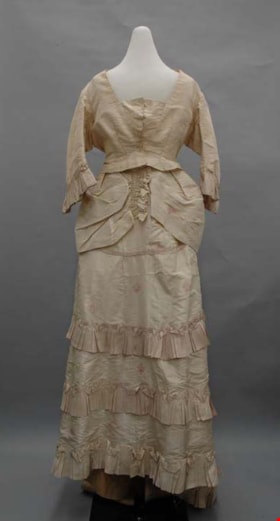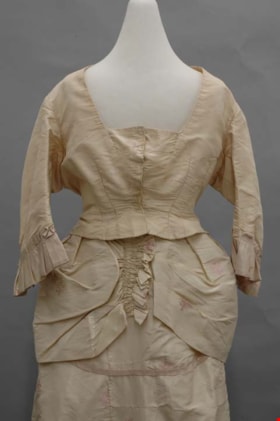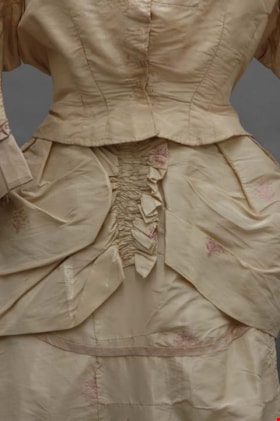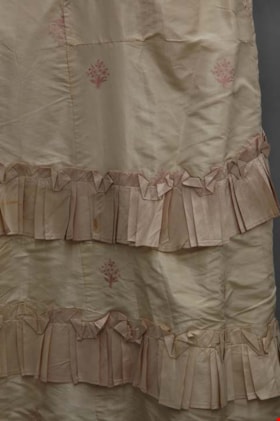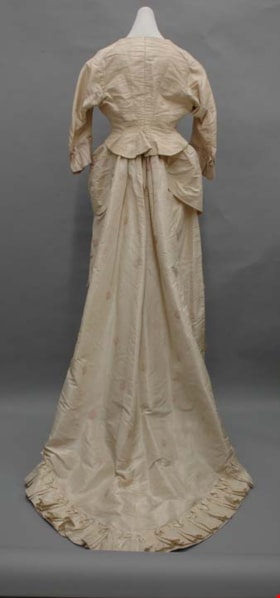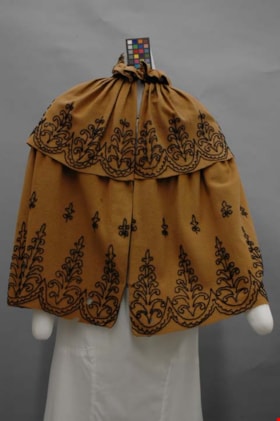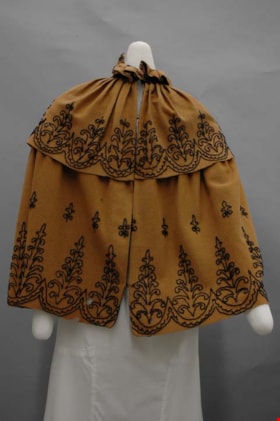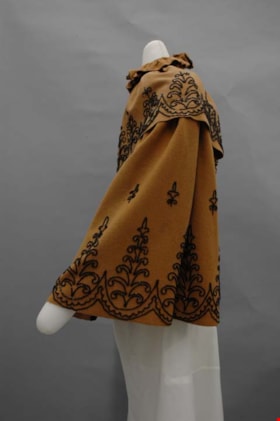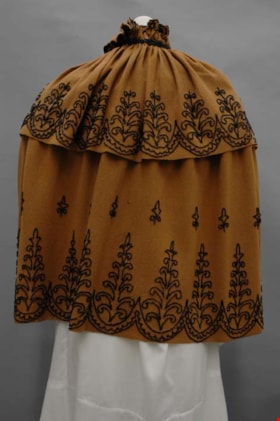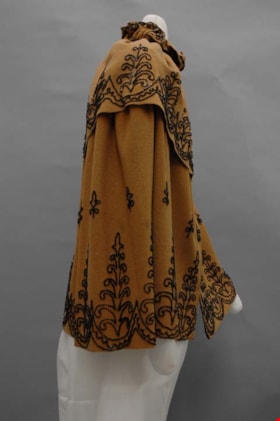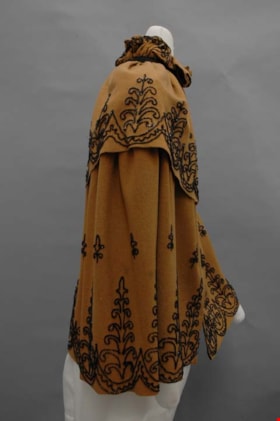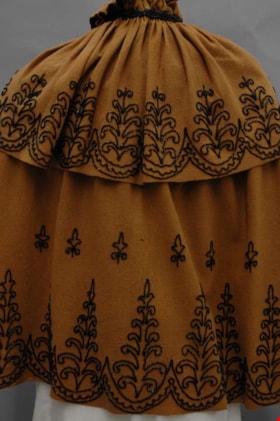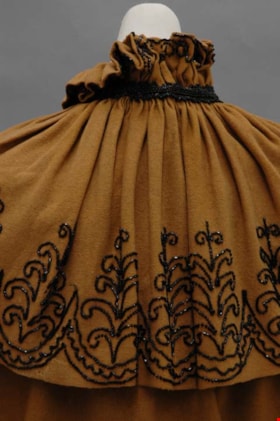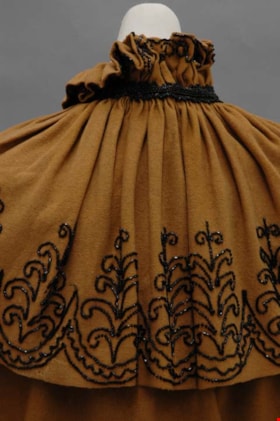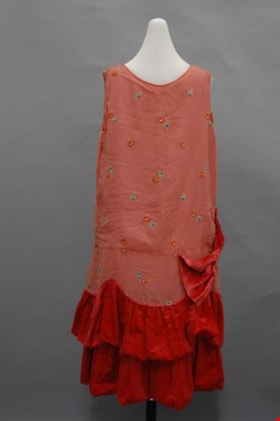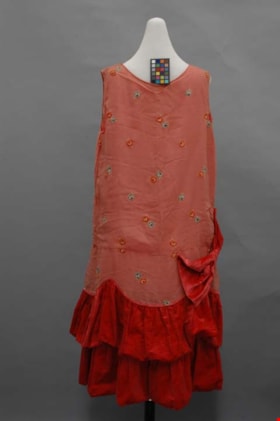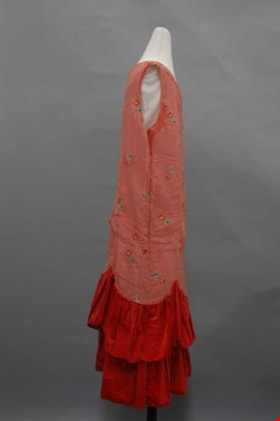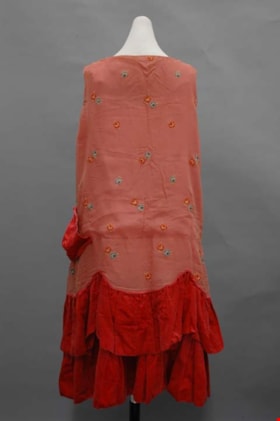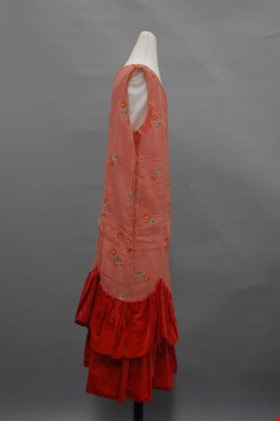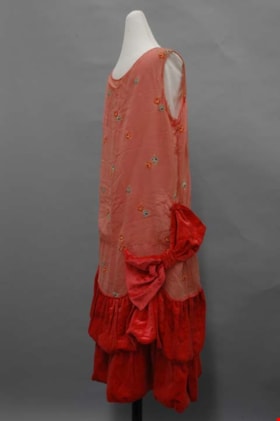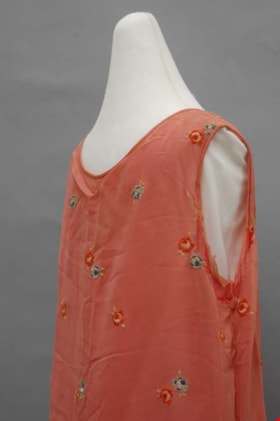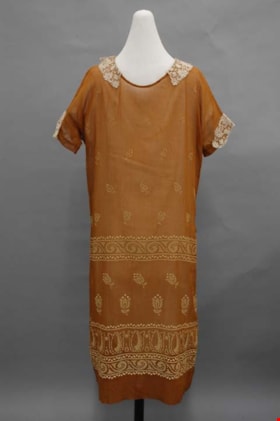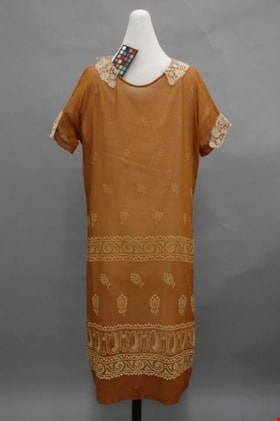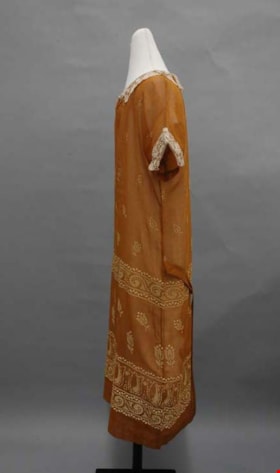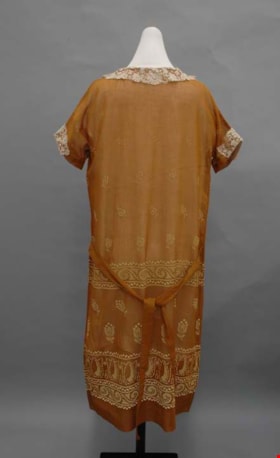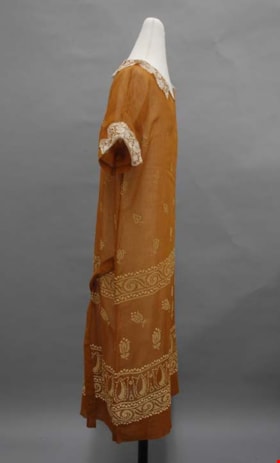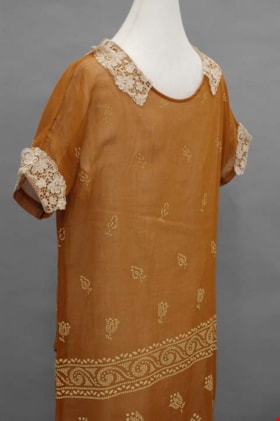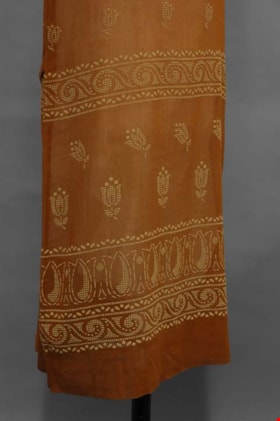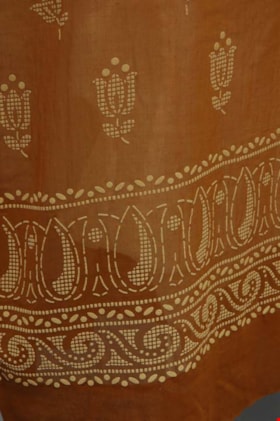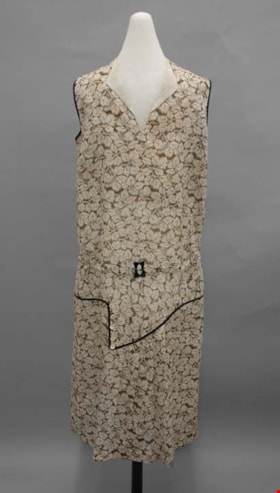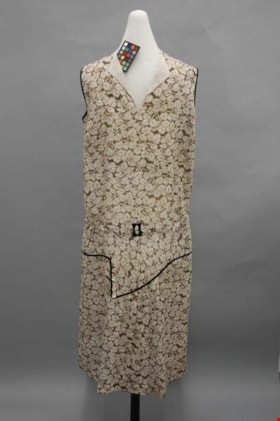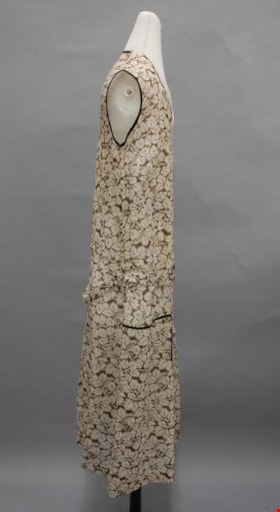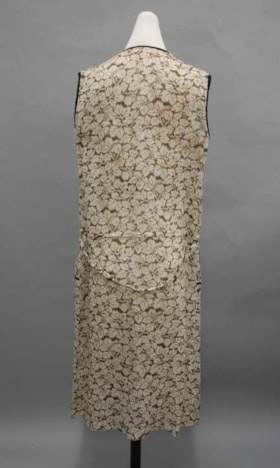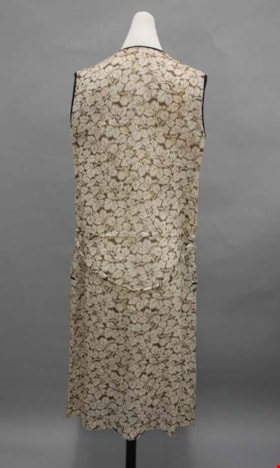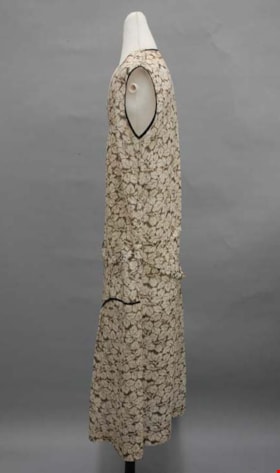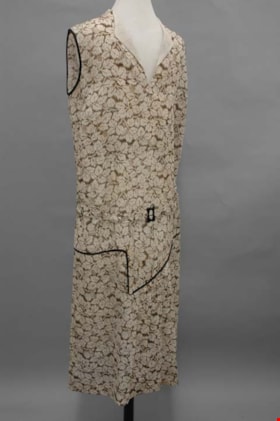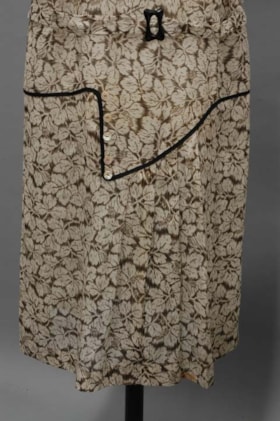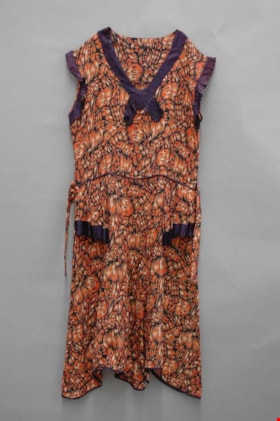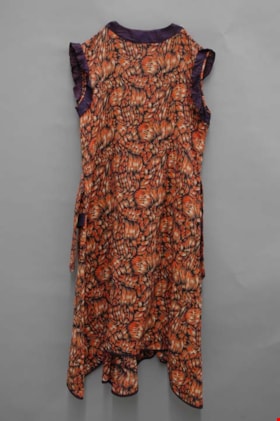Narrow Results By
wedding dress bodice
https://search.heritageburnaby.ca/link/museumartifact27496
- Repository
- Burnaby Village Museum
- Accession Code
- HV974.116.1
- Description
- Wedding dress bodice, c.1900. Green silk taffeta. Trimmed with black lace and green bows. Standing collar, leg o' mutton sleeves, small puff at front, shirring at waist. The bodice has a standing collar covered in black lace, and a flounce of the same lace going down each side front. The shoulders are shirred with a self fabric bow at the front of each shoulder. The sleeves are heavily gathered at the armscye to create a puff at the shoulders, which tapers down to a fitted width at the wrist. There is no cuff, but there is a small slit so that the wearer's hand can fit through. The bodice has a box pleat at either side of centre front and one at centre back; each connects to the shirring at waist level, which extends as far as the pleats on both front and back. Beneath this, the bodice flares out as a peplum and ends at the hips. Inside, the bodice is lined in brown cotton. An inner lining closes at centre front with hooks and eyes, and the front of the bodice (which is lined itself) closes with hooks and thread eyes at the left side. This continues up to the shoulder, and the collar closes at centre back.
- Subjects
- Clothing
- Clothing - Costumes
Images
tea dress
https://search.heritageburnaby.ca/link/museumartifact29842
- Repository
- Burnaby Village Museum
- Accession Code
- HV973.72.1
- Description
- Tea dress, c. 1915. Ivory cotton lawn and lace. Circular neckline, elbow length sleeves, and ankle length skirt. Closes with buttons down centre back. The bodice starts with a neckline in lace, extending to the side back and down the centre front to the waistline. The centre back lace is divided by cotton lawn, pin tucked at the neck. The side front and back bodice are cotton lawn half covered in lace panels. Tiny pin tucks on the side cotton extend from the front shoulder to the back waistband, separated at the shoulder line by bands of lace. The waist is a band of cotton covered in evenly spaced tiny pin tucks, horizontally bordered on top and bottom by bands of lace. It slopes up to a point in centre front, and has a hill and valley shape in back. There are three flower lace medallions on its front, one centre front and one on each side front. The sleeves begin with bands of cotton, lace, and cotton again. They then have bands of wide lace, narrow lace, wide, and narrow again, finished by a small scalloped lace cuff. The skirt is bordered on either side by a vertical strip of lace from waist to hem. From the waist to just below the hips, there is a section of cotton with tiny regular pin tucks. Under this there is a large band of lace that points downward in a V shape at centre front and back. This is followed with a cotton section, lace, cotton, lace, and a truncated cotton section. Then there is a straight band of lace, followed by a lace hem. The dress is machine sewn, unlined, and closes with small mother of pearl buttons that go halfway down centre back of the dress. There are seams on the sleeves, side bodice, and centre back under the button closure, which are french seams. The rest of the dress shaping is formed with lace panel inserts.
- Object History
- Worn in Vancouver by the donor's mother, Margaret (MacLeod) McKay.
- Subjects
- Clothing
- Clothing - Costumes
Images
evening bodice
https://search.heritageburnaby.ca/link/museumartifact29988
- Repository
- Burnaby Village Museum
- Accession Code
- HV973.73.147
- Description
- Evening bodice, c.1910. Black satin silk. V shaped panels over shoulders to centre front and back, half length sleeves with white ruffle cuff, pleated waistband, embroidery. There are two pleated panels that go over each shoulder and angle down to meet at centre front and cross over at centre back. They have three knife pleats, and on the half closest to the centre they are covered with floral embroidered net. At the back the opening left by the crossover panels is filled with a plain black piece; at the front, it is filled with a black piece covered in embroidered net. The sleeves are unlined, with a dress shield at each underarm. There is a bound hole above each elbow. The hole is 'closed' with a false self bound button. The cuff is ivory chiffon with mini pleats and drawn thread embroidery at its edge. At the bottom of the bodice, which is round at the back and pointed down slightly in the front, there is a waistband with four pleats. At the centre front, five self covered buttons are aligned in a vertical line, one to each pleat section. The bodice is lined with purple cotton and eleven bones. Attached to the centre back at waist level, there is also a grosgrain ribbon belt. The belt has an embroidered label that reads: "James Spence Co. Ltd., 75 to 79 St. Pauls Churchyard Churchyard, London, EC. Ball & Dinner Dresses, Ladies' Tailor." The bodice lining and waistband closes at centre front with hooks and eyes (the waistbands also over laps and connects with hooks and eyes to the left). The front embroidered panel connects with snaps underneath the left pleated panel.
- Subjects
- Clothing
- Clothing - Costumes
Images
bodice
https://search.heritageburnaby.ca/link/museumartifact29996
- Repository
- Burnaby Village Museum
- Accession Code
- HV973.73.155
- Description
- Bodice, c.1870-1875. Olive green silk shot with purple, with purple brocade, ribbon, and cotton twill piping. Buttons down centre front, high neck, long sleeves, cuirass design. The stand collar is fairly small, with a close neckline. It is made of a mauve silk brocade with a pattern of tiny purple ovals. There is a panel of this fabric that goes down the centre front and centre back from the shoulders to the hem, separated from the main fabric by purple twill piping. At the centre front, the bodice also closes from top to bottom with twelve buttons covered in mauve fabric with a brocade flower and a hook and eye at the collar. At the centre back there is another line of purple piping, and there is a self fabric covered button on each outside line of piping at the waist level. The rest of the front and back bodice is made of the olive and purple shot silk, with two darts at each side front. The armscyes are sewn with purple piping, and the sleeves are made in the olive and purple shot silk. At the cuffs, there is a band edged in purple piping and trimmed with a mauve ribbon bow. Beneath this there are two tiers of pleated ruffle in the mauve brocade. At the hem of the bodice, there is a double row of purple piping. The bodice is lined in brown linen. It has short bones in each front dart, and one in each side seam. The section below the waist is lined in purple china silk.
- Subjects
- Clothing
- Clothing - Costumes
Images
bodice
https://search.heritageburnaby.ca/link/museumartifact30003
- Repository
- Burnaby Village Museum
- Accession Code
- HV973.73.162
- Description
- Bodice, c.1900. Plum silk taffetta with dark purple velvet standing collar, yoke, cuffs, arm bands, and waistband. Bishop sleeves, slightly puffed front. The purple velvet yoke beneath the velvet standing collar is triangular in both front and back. It is bordered by three pleats. At the front, there are pleats just above the velvet waistband that open up to create some fullness. The bodice closes up the centre front with hooks and eyes, and the collar closes at the back with two hooks and thread eyes. The sleeves taper out to a velvet band at the elbow. They are then covered in pin tucks on the outside, and gathered at the wrist to a velvet cuff. Inside, the bodice is lined with brown cotton twill. It has a pleat on each side front and six panels in the back. There are nine bones to keep its shape. In the underarms, there are dress shields labeled "Countess" above an ornate abstract logo.
- Subjects
- Clothing
- Clothing - Costumes
Images
bodice
https://search.heritageburnaby.ca/link/museumartifact30137
- Repository
- Burnaby Village Museum
- Accession Code
- HV973.94.10
- Description
- Bodice, c.1830s. Cream coloured cotton with brown and green abstract print. Natural waist height, round waist with point at centre front, long sleeves, corded seams. The round neckline has cording, as do all the other seams. On the front of the bodice, there is a decorative tuck of fabric that runs from either side of the centre front waistline in a curve to each shoulder. It is attached with a corded seam at its base. There is also cording on the centre front seam, and on the armscyes. The sleeves are narrow except for at the elbows, where slightly more volume is created with gathering on one side. At the cuffs there is a small band of fabric an inch from the end. At the bottom of the centre back, there is a self fabric rosette. Inside, the bodice is lined in white cotton. There is a dart on either side front, and all the seams are left unfinished. It opens down the centre back, and has flat hook and eye closures. This bodice for a day dress is entirely hand sewn, as sewing machines were not yet available.
- Subjects
- Clothing
- Clothing - Costumes
Images
tea dress
https://search.heritageburnaby.ca/link/museumartifact30142
- Repository
- Burnaby Village Museum
- Accession Code
- HV973.94.15
- Description
- Tea dress, c.1910-1912. White cotton lawn with lace. Half length sleeves, floor length somewhat flared skirt, round neckline, natural waist height and width. The top centre front and back of the dress is made of lace, with a separate piece on the breast and an appliquéd rose. Down the centre front, chevrons of lace are interspersed with sections of lawn. The waistline is made of alternating bands of lace and lawn, and it extends from the side fronts around the back. The sleeves are made of bands of pin tucked lawn and lace, ending in lace. From each shoulder on front and back, there is a band of lace that extends straight down to the hemline. There is also a band of this lace that extends from the waistline to the hem on each side. On the sides and back panels of the flared skirt, there are sections that are pin tucked from the waist with three chevrons of lace near the bottom. The floor length hem is decorated with three horizontal tucks. The dress opens at centre back from the neckline to just past the hips. It closes with pearl buttons at the bodice and skirt, and hooks and eyes at the waist.
- Subjects
- Clothing
- Clothing - Costumes
Images
dress
https://search.heritageburnaby.ca/link/museumartifact30158
- Repository
- Burnaby Village Museum
- Accession Code
- HV973.94.31
- Description
- Dress, c. 1910. Black and mint green damask, black satin silk trim. Bodice, skirt, cumberbund. Square neck with studs, short sleeves, slight pouter pigeon, floor length skirt. The bodice has a large square neckline that is trimmed in front and back with a band of black satin. On the front, there are also bronze coloured studs arranged in triangle shapes. The sleeves are pleated at the top of the armscye. They have a self fabric band applique just above a cuff of black satin trim. The bodice front is gathered at the neckline and waist, and it is also longer to create a small pouter pigeon front. The cumberbund has five bones covered in ruching, at centre back, both sides, and each centre front end. It closes with three hooks and eyes at centre front, which is longer than the others and tilted forward slightly. The skirt has a jean waistband with seven gores. It opens in the centre back and has hook and eye closures. It is not really flared, but the waistband has been taken in at two spots at the right side to make the waist smaller. The hem is trimmed with a self fabric band.
- Subjects
- Clothing
- Clothing - Costumes
Images
evening bodice
https://search.heritageburnaby.ca/link/museumartifact30792
- Repository
- Burnaby Village Museum
- Accession Code
- HV972.5.2
- Description
- Evening bodice, c.1860-1865. Silk taffeta ikat design, cream background with purple stripes and flowers. Low round neck, short puff sleeves, round natural waist length. The low round neckline is bordered by a thin purple velvet ribbon, and the neck edge is corded. The short puff sleeves rest low on the shoulders with corded seams, and they are gathered into a cuff trimmed with the same velvet ribbon. The front of the bodice has a centre panel and two side panels with top stitched seams that run in an upwards arc from the underarms to either side of the centre front. The back of the bodice has two darts on either side, and a centre back closure of hooks and thread eyes. Inside, the bodice is lined in white linen. It has boning in each side seam, as well as each back dart. At the bottom, there is a waist band of the same fabric. The bodice fabric print consists of a cream background with vertical purple stripes separated by vertical floral zig-zags. The zig-zags are connected the green stems, and at each corner there is a bud in a pattern of pink, blue, and purple.
- Subjects
- Clothing
- Clothing - Costumes
Images
wedding dress
https://search.heritageburnaby.ca/link/museumartifact30794
- Repository
- Burnaby Village Museum
- Accession Code
- HV972.5.4
- Description
- Wedding dress, c.1913. The fabric is an ivory silk chiffon, lined in white satin silk. The skirt extends mid-calf, the sleeves three-quarter length, and there is white beaded decoration on the bottom front of the skirt, as well as the front of the bodice. The silhouette of this dress shows the then fashionable shape of a raised waistline, as well as the poufed blouse front that was still popular. The fabric is light, flowy, and airy, but the cut has straight lines in features such as the bodice panels and large skirt pin tucks. The bodice closes via a panel that hangs down the front, attaches to the waist, and extends down the bodice back. There is an additional panel that attaches on each side front neck, forming a collar, and hangs down the back in a triangular shape. The front panel closes on the left side at the waist and at the left shoulder with snaps. There are two beaded floral starburst patterns, one each on the left and right side of the front bodice panel, connected with three curved lines. There is also a single line of white beads along the edges of the front bodice panel, and both back panels, including the front and side neck. The sleeves connect to the dress lining under the bodice panels. Each has a hanging panel around the elbow line which looks like four triangle shapes that point upwards, tacked above the elbow line. The cuffs are narrowed with a dart and two pin tucks, with a hook and eye closure on a bound placket. Around the waist, there is a belt that connects to itself with snaps, and is tacked to the waistline in the centre back. There are two snaps on the left side waist that may have once been used to secure the belt, but the belt no longer has any corresponding snaps. The skirt is somewhat gathered at the waist, more in the back than the front, and consists of three slightly flared gores. The front gore is plain except for a white beaded floral starburst motif near the bottom front. Three beaded tendril lines extend from either side, spanning the width of the front gore. The other two gores each extend from the side fronts to the centre back; they each have two three inch pin tucks, just above knee level and one below, that hang downwards and extend to centre back. The lining is attached at the waist, and hangs freely under the skirt. It has a front and back gore, as well as two triangular gores on each side starting at knee level. In the bodice it is attached at the neck and shoulders, where it attaches to the unlined sleeves. It closes on the left front with hooks and eyes. Inside the lining, the waist is reinforced with three inch cotton grosgrain ribbon which closes at centre front with hooks and eyes. The dress is sewn mainly by machine with french seams, although the four inch hem is hand sewn with a whip stitch. The sleeve pin tucks are also hand sewn. The length of the skirt lining was reduced just above its hem with a one inch hand stitched tuck.
- Subjects
- Clothing
- Clothing - Costumes
Images
wedding dress
https://search.heritageburnaby.ca/link/museumartifact30795
- Repository
- Burnaby Village Museum
- Accession Code
- HV972.5.5
- Description
- Wedding dress or perhaps a regular dress once worn as a wedding dress, c.1910. Made from a heavyweight beige cotton. Embroidered net collar and yoke, and embroidered front panel. Princess seams and pin tucks form a flared, pleated skirt. Long sleeves, and pink edging on some seams. The fabric is a heavy, somewhat glossy cotton that makes the dress seem more like an item to be for everyday activities instead of as a wedding dress. Its silhouette is distinctive of the late Edwardian period, with its higher waist, close natural shaping, and somewhat flared ankle length skirt. In the bodice, two pleats on each side front create fullness. The collar and yoke are made of netting, lined with white silk, edged with pink ribbon, and embroidered in an undulating pattern of lines. There are two small brown buttons (previously covered in pink fabric) on either side of the net yoke. Two pin tucks run the length of either side of the back bodice. The sleeves are full length, with gathered caps and nine 1cm pin tucks down the length of each. There are two false previously pink buttons on each cuff, which are also edged in pink. A two inch waistband extends from the centre front panel to the back. There is a previously pink button on each front corner, and the whole band is edged in ribbon. The top left button is missing. It has a pink lining on the inside. The skirt is made up of six gores, not including the centre front panel. The left and right side of the skirt each have eight pleats, released halfway down with pin tucks. On the centre back, a pin tuck on either side of the closure released a large inverted box pleat. A false hem is hand sewn at the bottom, and machine sewn at its top. The dress closes with hooks and eyes along the centre back, from the top of the collar to a third of the way down the skirt. On the centre front, there is a panel that extends from the shoulders to the hem, using princess seaming. It is edged along its seams with pink ribbon. It is covered in in a hand-applied ribbon of couched thread, as well as some embroidered french knot flowers down the centre front line. The dress is mainly machine sewn. Seams are finished by whip-stitching the seam allowances together when the selvedge is not used.
- Subjects
- Clothing
- Clothing - Costumes
Images
dress
https://search.heritageburnaby.ca/link/museumartifact31799
- Repository
- Burnaby Village Museum
- Accession Code
- HV972.57.7
- Description
- Dress, c.1916-1917. White cotton voile. Long gathered sleeves, sailor collar, V neck with revers, calf length skirt with horizontal tucks. The sailor collar hangs in the back as a large square and extends around the front V neck in wide revers. It has two rows of wide tucks, each topped with drawn thread embroidery. At each front shoulder, there are eleven tiny pin tucks; there are seven of the same at each side back that extend to the waist. The sleeves have a corded seam at the armscye and where they connect to the cuff. Each has eleven tiny pin tucks coming from the cuff, as well as gathering. The cuff itself has a base covered by the same shape as the collar with the same embroidery. There are three thread covered ball buttons to close the cuff. At the waist, the bodice is gathered and the skirt is heavily gathered. The skirt is made on one front panel and two back panels, with four large horizontal tucks past knee level and a large turned up hem. There is no lining, but there is a grosgrain belt inside the waistline that closes with hooks and eyes The dress closes with snaps along the front centre and left waist and one hook and eye at the left side seam. There are also snaps on the left side seam down to the hip.
- Subjects
- Clothing
- Clothing - Costumes
Images
Woman's suit
https://search.heritageburnaby.ca/link/museumartifact32163
- Repository
- Burnaby Village Museum
- Accession Code
- HV972.90.3
- Description
- Woman's suit, c.1892. White linen with hand worked embroidery. High collar, long full sleeves, flared floor length skirt, puffed bodice front, long ties in bodice back. The high collar has point de gaze lace edging, and is covered in hand worked floral embroidery. Down the centre front of the bodice there are four tiny pin tucks. There is more floral embroidery on either side front, and a large tuck on either side of that covering the shoulder seams and angling slightly towards centre front. The tucks continue down the bodice back on the same way. On the top back of the bodice there are seven more tiny pin tucks on either side. Down the centre back there is an opening with five white pearl buttons. At the bodice back bottom there is some gathering covered with a long tie on each side. These may have been used to tie around the front, which would otherwise hang open around the waist. The sleeves have some volume, although they lack the large leg o' mutton cap. They are gathered at the cuff, which has a band of floral embroidery and is edged in point de gaze lace. The separate skirt has a grosgrain waistband and opens down the centre back with four snaps and a hook and eye at the top. There are five gores, with floral embroidery down the centre front. The dress is unlined, and the seams are finished with a whip-stitch.
- Object History
- This suit was worn by Bertha May Shaw in 1892, likely in Regina, Saskatchewan.
- Subjects
- Clothing
- Clothing - Costumes
Images
woman's suit
https://search.heritageburnaby.ca/link/museumartifact32291
- Repository
- Burnaby Village Museum
- Accession Code
- HV972.107.3
- Description
- Brown women's suit circa 1900. The fabric of the dress has a faint tone on tone striped pattern. There is a lace insert at the neck of the bodice with a floral applique. The bodice has a hook and eye closure hidden down the front. There is whale bone in the bodice to hold the structure of the garment. The skirt has two wide "tucks" around the hem.
- Subjects
- Clothing
- Clothing - Costumes
Images
dress
https://search.heritageburnaby.ca/link/museumartifact32391
- Repository
- Burnaby Village Museum
- Accession Code
- HV972.114.1
- Description
- Dress, c.1884. Beige silk taffeta and ivory silk floral brocade, mauve trim. Bodice with low square neck, half length sleeves with ruffle cuffs. Skirt with train, drapery around hips, ruffles down front. Trousseau for wedding. The bodice is made of beige taffeta, lined with white silk twill sewn together with the main fabric. It has a low square neckline. Its half length sleeves are attached at the armscye with a corded seam, and at the cuff they have a large pleated ruffle in mauve silk taffeta lined with the same fabric as the skirt. Besides this, there is no decoration on the bodice (it is noted in the accession file that the trim is missing from the bodice). Shaping comes from two darts on either side front and six panels in the back. There is boning in each dart and one in each side seam. The bodice extends to the hips, cinching in at the waist. At the centre back of the waist there is a white silk ribbon the extends to the left, and may have also been on the right as well originally. It closes at centre front with hooks and eyes. The skirt is made of ivory brocade with a sparse pattern of small pink floral bouquets. It has a grosgrain waistband that closes with two hooks and eyes at centre back. The opening in the skirt below does not have any closures. There are six gores, all sewn together with the cotton voile lining except for the centre front seam. At the top of the skirt there is a section of drapery (also lined in cotton voile) that circles around the hips to the side backs. It is ruched at centre front in three vertical lines. Under the drapery on the right side, there is a pocket with a cotton twill bag inserted into the seam. The skirt is heavily pleated at the back, where there is also a long train. The front or the skirt, extending to the front two gores, has a thin band of mauve ribbon right under the top drapery. Regularly spaced down the front of the skirt there are two rows of mauve pleated ruffles, like those on the bodice cuffs. At the hem there is another pleated ruffle that runs its whole length, made of the main dress fabric. The bodice is entirely hand sewn. The straight seams on the skirt are sewn with a chain stitch machine, and the rest is done by hand. The seams are finished with whip-stitching where the selvedge is not used.
- Object History
- This dress was part of Bella Rebecca Max's trousseau. She married Louis Levy in 1880 in Ontario.
- Subjects
- Clothing
- Clothing - Costumes
Images
cape
https://search.heritageburnaby.ca/link/museumartifact33275
- Repository
- Burnaby Village Museum
- Accession Code
- HV972.165.211
- Description
- Women's wool cape - light brown colour. The cape is beaded with small black beads in a fern pattern. There are small holes in the cape, possibly caused by moths.
- Subjects
- Clothing
- Clothing - Costumes
Images
dress
https://search.heritageburnaby.ca/link/museumartifact35945
- Repository
- Burnaby Village Museum
- Accession Code
- BV993.53.87
- Description
- Dress, c.1929. Pink chiffon, red chiffon, and red velvet. Straight cut, sleeveless, embroidered flowers on bodice, two velvet flounces on skirt, velvet bow on left side. The bodice, with its boat neck and lack of sleeves, has two layers. The outer layer is pink chiffon and the under layer is red chiffon. The outer layer is covered in a regular yet sparse pattern of flowers in either blue or orange with white. At the left side of the dropped waist there is a large red velvet bow. The two bodice layers are sewn together at this point, and the skirt begins a few inches below with a wavy corded velvet seam. The skirt consists of two tiers of gathered red velvet flounces, hemmed with a zig-zag stitch. The first tier is attached to the pink outer layer and the second tier attaches to the red under layer, just high enough to be visible as velvet from the outside.
- Object History
- These items are from the Bailey family home at 6080 Kathleen Street (built in 1922) in the Central Park area.
- Subjects
- Clothing
- Clothing - Costumes
Images
dress
https://search.heritageburnaby.ca/link/museumartifact36987
- Repository
- Burnaby Village Museum
- Accession Code
- BV995.20.91
- Description
- Dress, c.1925-1928. Bronze coloured cotton organdy with yellow glass glitter embellishment. Lace collar and cuffs, tie at waist, straight shape. The collar is lace, applied at a round neckline and extending to the side fronts. The dress is a straight cut, without any shaping. There are ties sewn into side seams where a drop waist would be. The upper part of dress has floral (perhaps tulip) pattern embossed into the dress with glitter: small at the top, getting progressively larger toward border area below the ties. The cuffs, attached at the end of short kimono sleeves, are ecru lace as well. The border below waist has scroll and oval design, which repeats above hem. Above the bottom border is one of of tulip and oval shapes. Between the two borders are more large tulips.
- Object History
- This dress was part of a collection of dresses acquired from a dry goods store in the Okanagan. The dresses were mainly "new" old stock from the 1920s, from two Rand’s Dry Goods stores in Penticton and Summerland, B.C. The stores closed down in 1930. The dresses are estimated to date from circa 1925 to 1930
- Subjects
- Clothing
- Clothing - Costumes
Images
dress
https://search.heritageburnaby.ca/link/museumartifact36988
- Repository
- Burnaby Village Museum
- Accession Code
- BV995.20.92
- Description
- Dress, c.1925-1928. White cotton voile with a brown leaf pattern. Sleeveless V-neck with small revers. Belt at dropped waist, calf length pleated skirt with decorative bias tape and buttons The neckline is bound with black bias tape at the back. It forms a V in front, faced with cotton organza. The armholes are also bound with black bias tape. There is shaping in the bodice is from a dart at each bust, and it flares out slightly at the waistline. There is a dropped waist, covered by a belt of the same dress fabric. It is tacked down at centre front with a decorative celluloid buckle. A few inches below the waistline there is a decorative band of bias tape. It runs horizontally from the right side for a quarter of the way, then turns straight down for about five inches. Here it is edged on its left with five pearl buttons. The bias tape then curves back upwards to its original height on the left side of the skirt. Under the curving bias tape, there are four pleats at centre front. The back of the dress is one unshaped piece, except for a horizontal tuck across back at the belt level.
- Object History
- This dress was part of a collection of dresses acquired from a dry goods store in the Okanagan. The dresses were mainly "new" old stock from the 1920s, from two Rand’s Dry Goods stores in Penticton and Summerland, B.C. The stores closed down in 1930. The dresses are estimated to date from circa 1925 to 1930.
- Subjects
- Clothing
- Clothing - Costumes
Images
dress
https://search.heritageburnaby.ca/link/museumartifact36998
- Repository
- Burnaby Village Museum
- Accession Code
- BV995.20.102
- Description
- Dress, c.1929. Orange and navy printed rayon. Straight cut, somewhat flared skirt with uneven hem. Navy trim on armholes, neckline, hip flounces, and knee length hem. The V neckline is trimmed with a band of navy fabric, with a small pleated tab on either side of the V point. The armholes also have pleated ruffles that point inwards, instead of sticking out of the armholes. At the front of the dropped waist, there is a corded seam in the navy trim. There is also a long tab at each side seam, which could be used as a belt if there were a buckle. At each side front, there is a pleated flounce in the main fabric, trimmed with a band of navy at the hem. The skirt is somewhat flounced, with a wavy hem. It curves down at the centre front, up at the side fronts, down at each side, and stays in a straight line at the back. The hem is bound with the navy trim.
- Object History
- This dress was part of a collection of dresses acquired from a dry goods store in the Okanagan. The dresses were mainly "new" old stock from the 1920s, from two Rand’s Dry Goods stores in Penticton and Summerland, B.C. The stores closed down in 1930. The dresses are estimated to date from circa 1925 to 1930.
- Subjects
- Clothing
- Clothing - Costumes
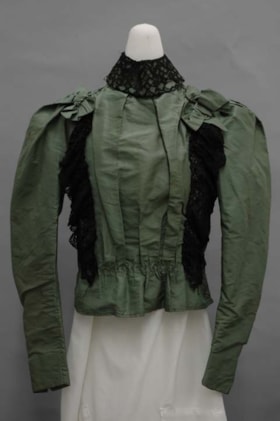
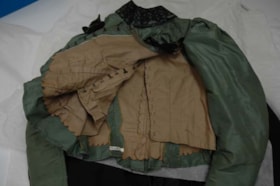
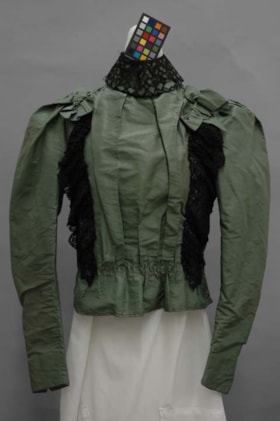
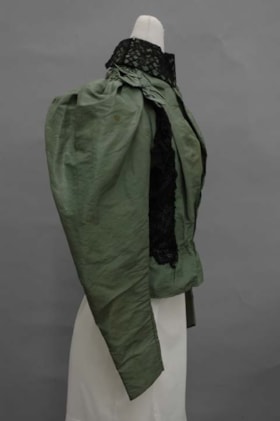
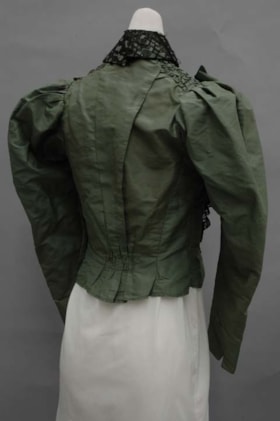
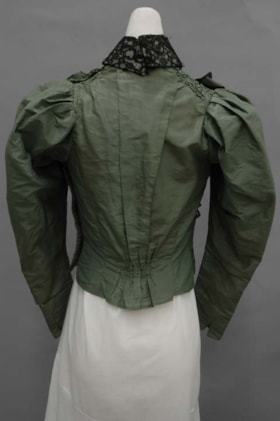
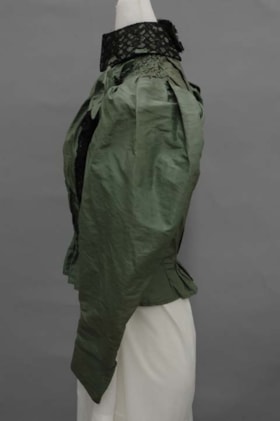
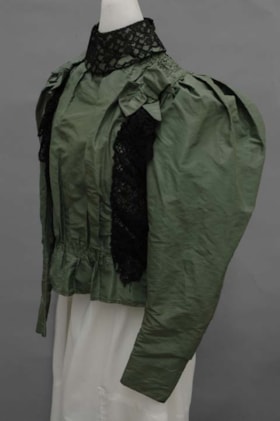
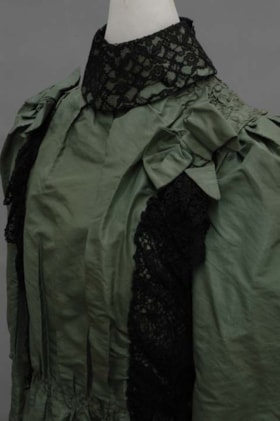
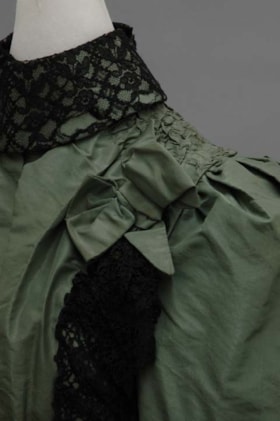
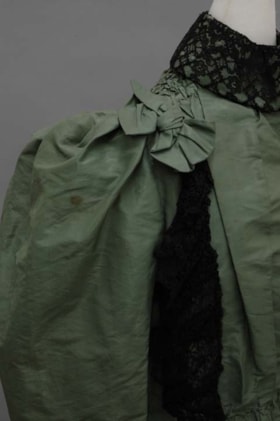
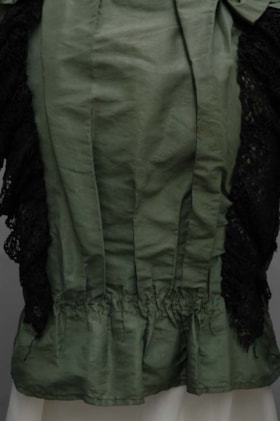
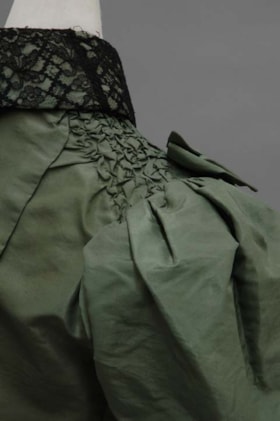
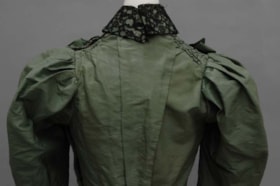
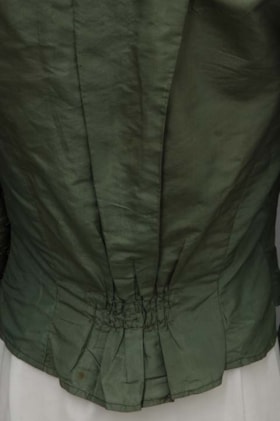
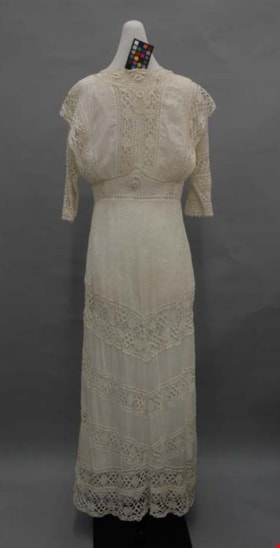

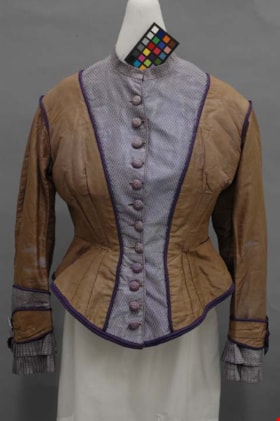
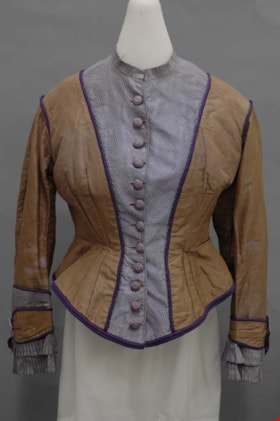
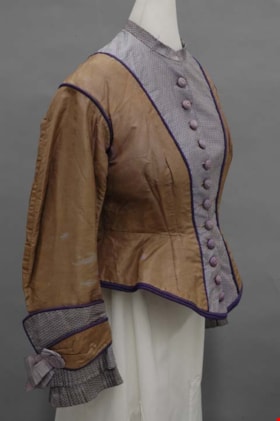
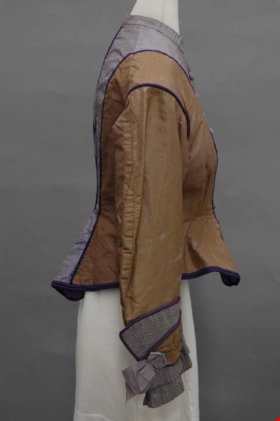
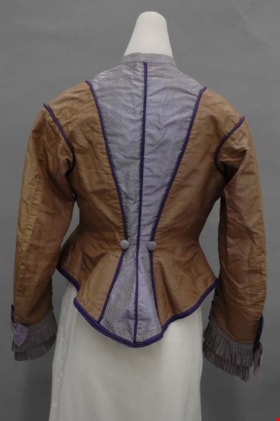
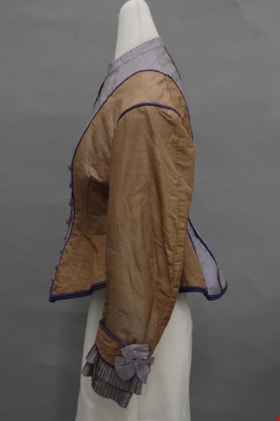
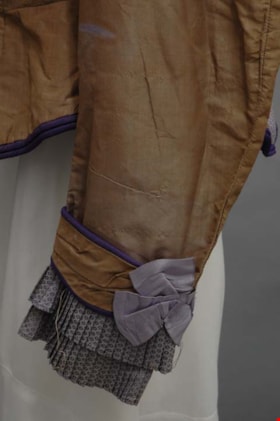
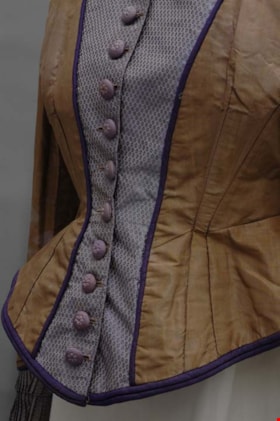
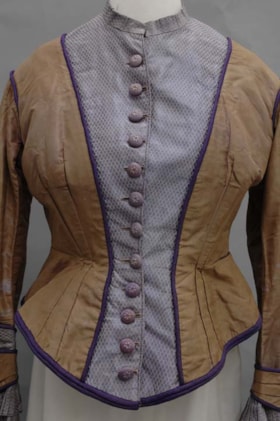

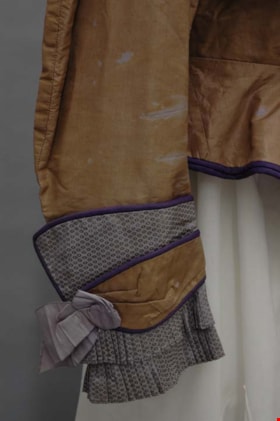
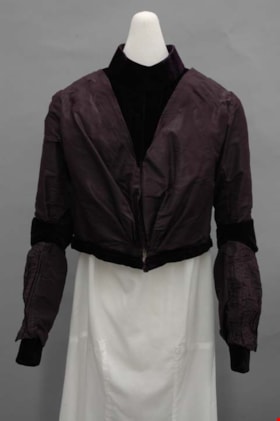
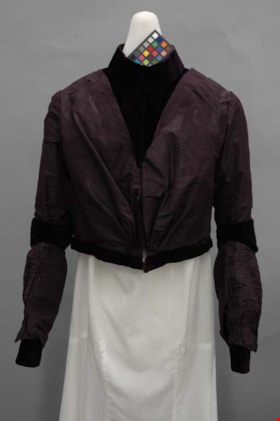
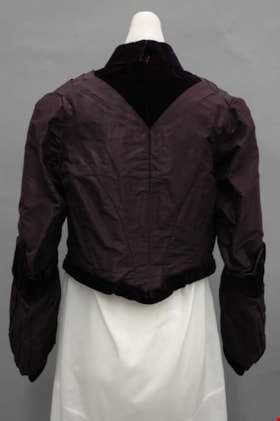

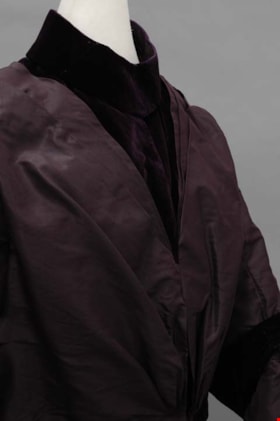
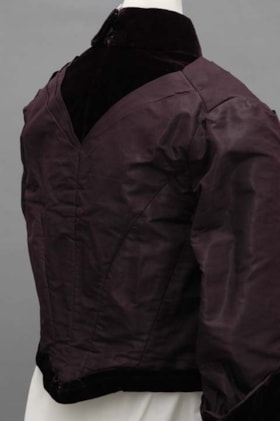
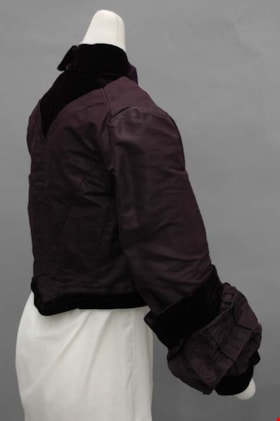
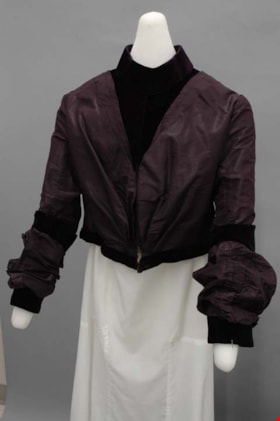
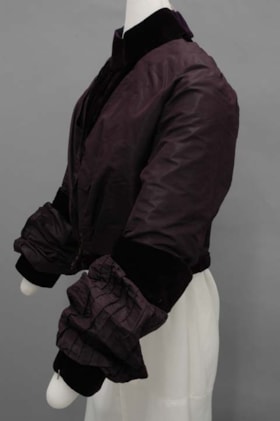
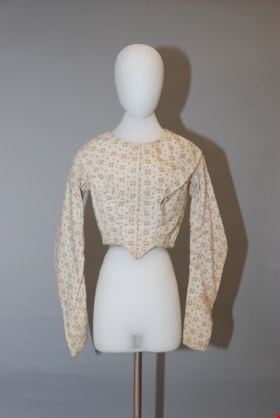
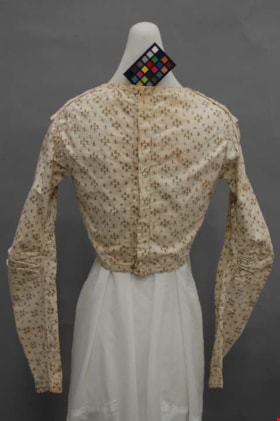
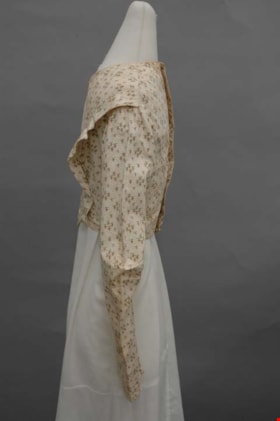

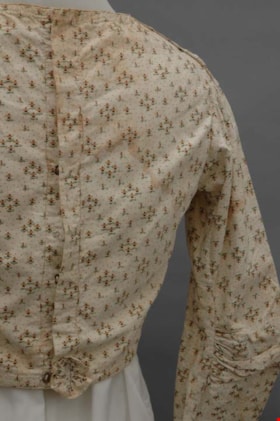
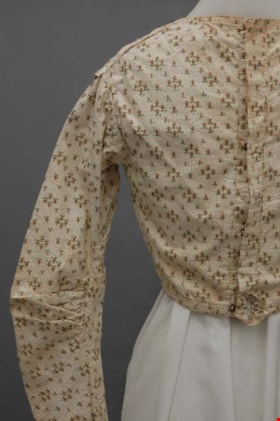
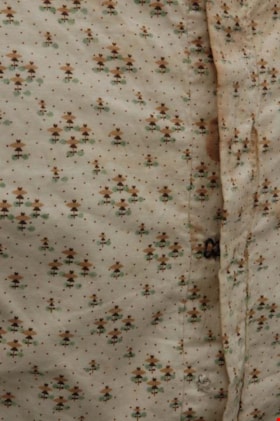
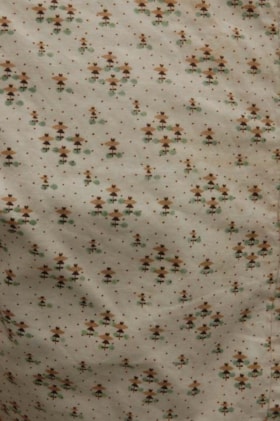
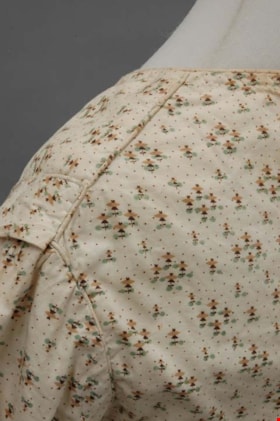
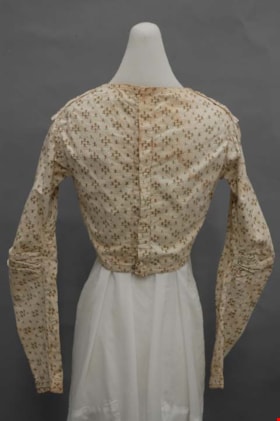
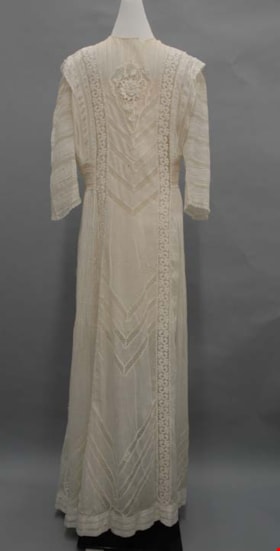
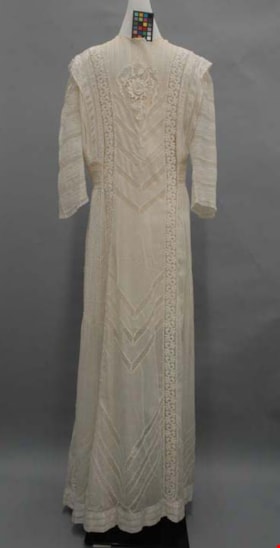
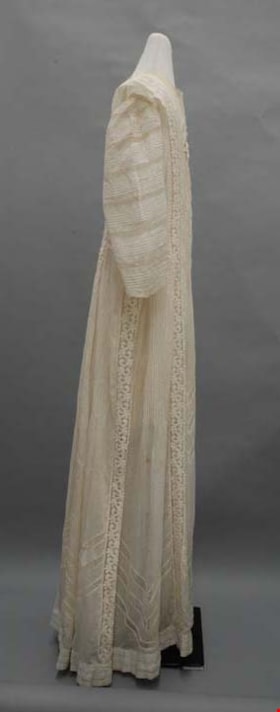
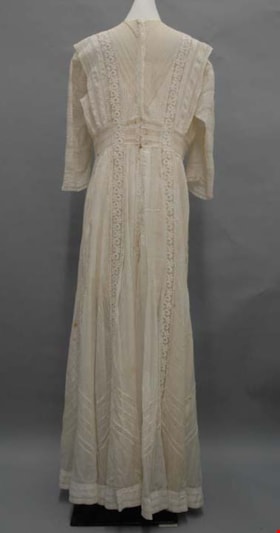
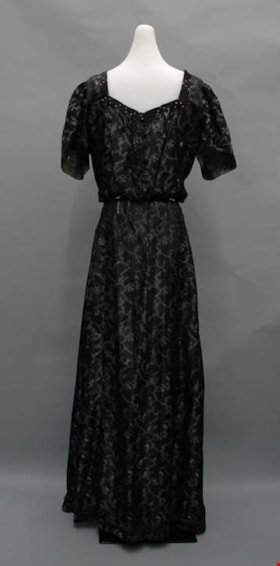
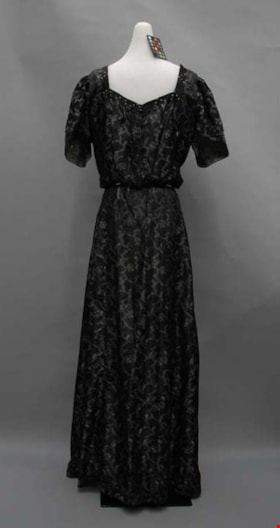
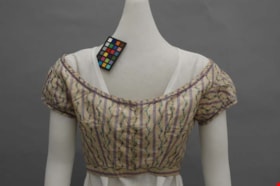
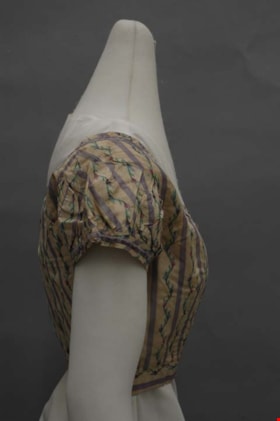
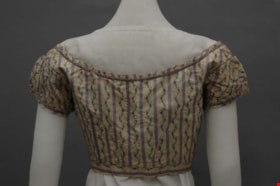
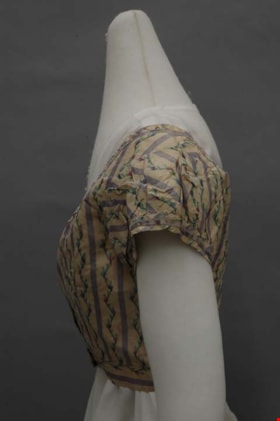
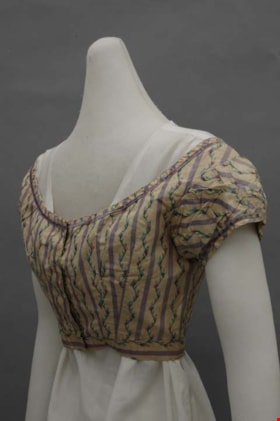
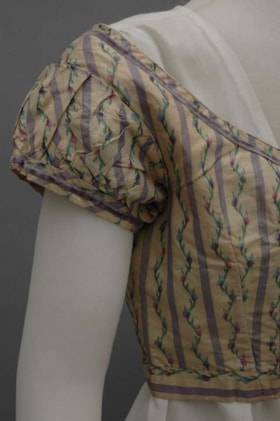
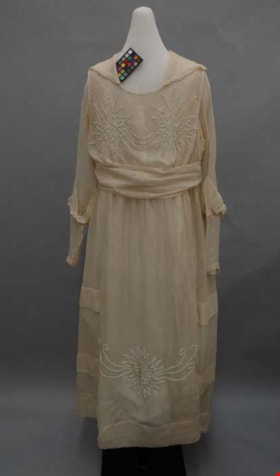
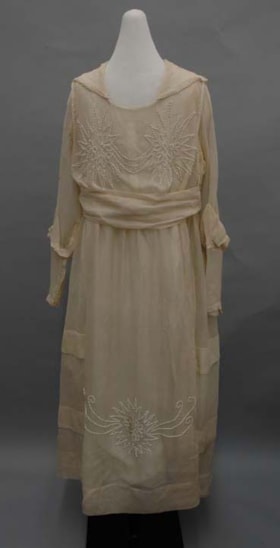
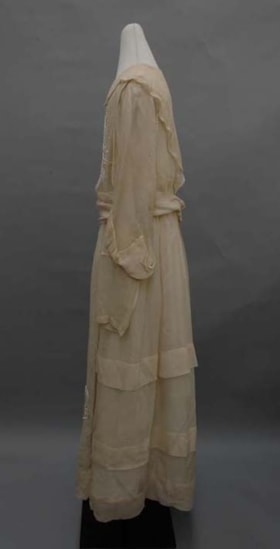
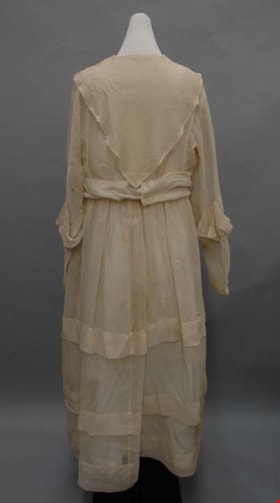
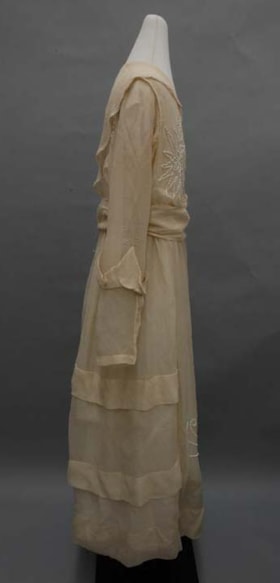
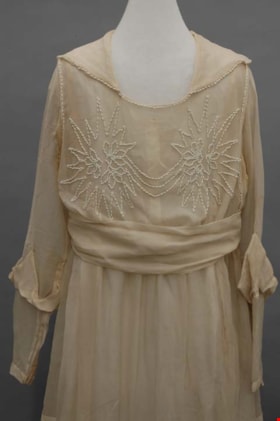
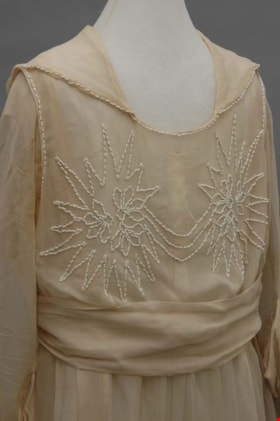
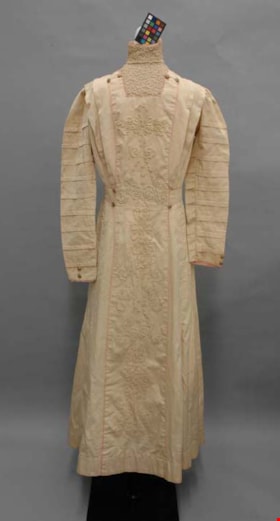
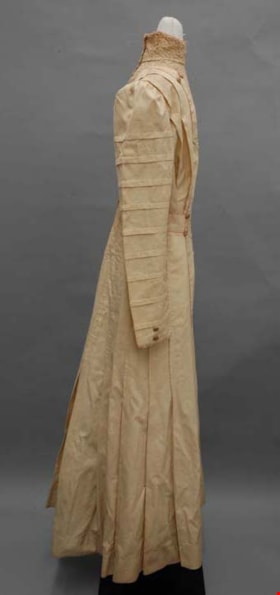
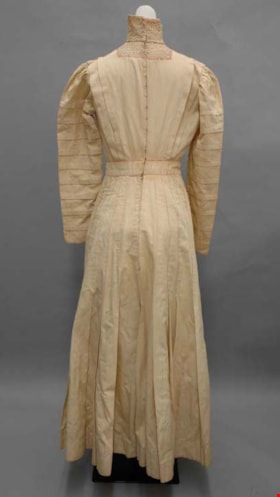
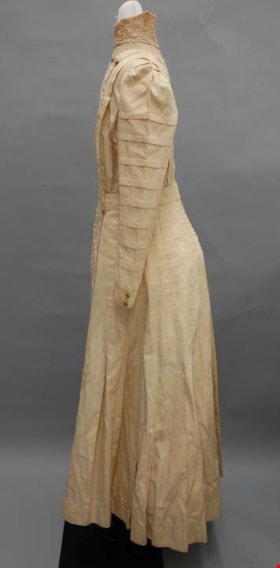
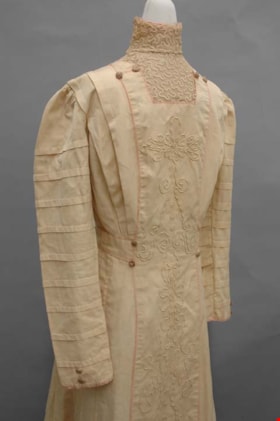
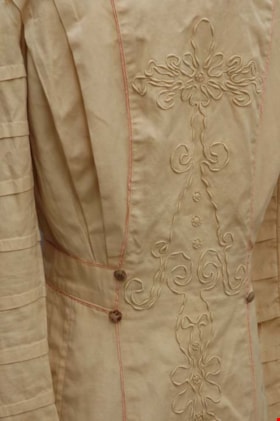
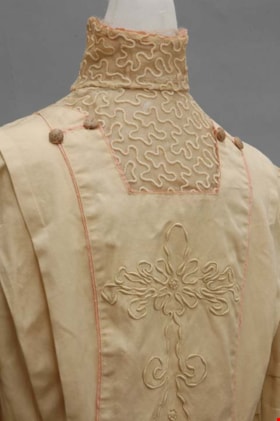
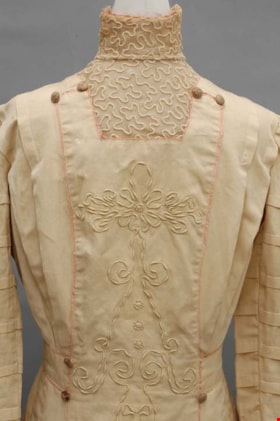
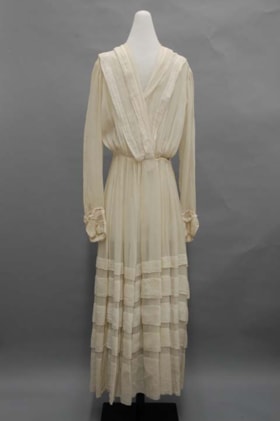
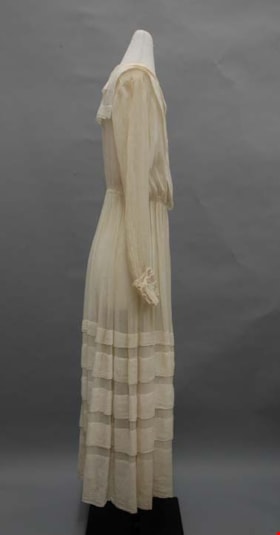
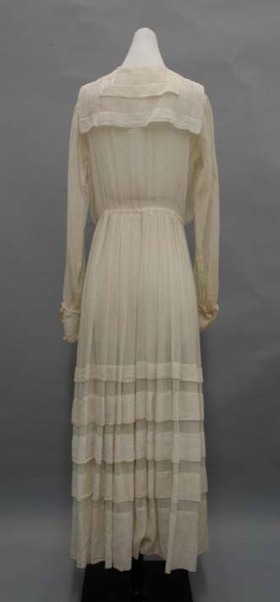
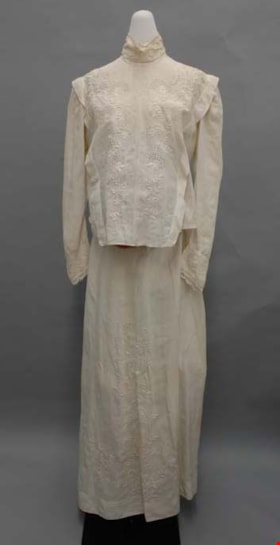
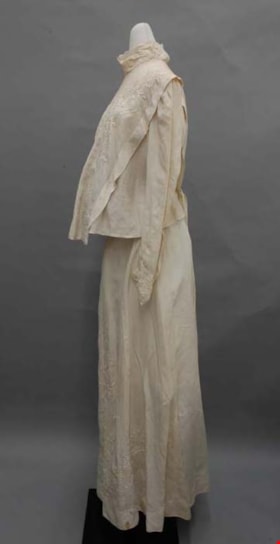
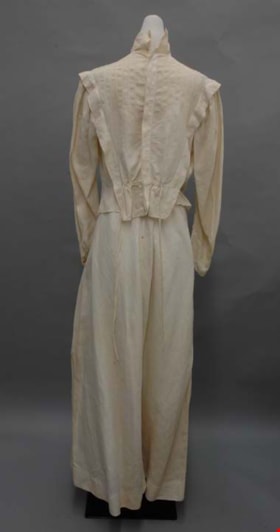
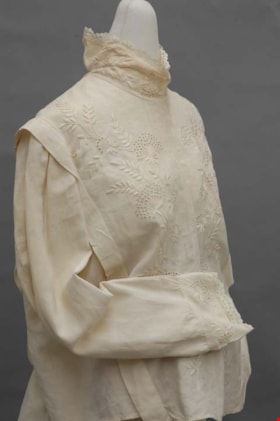
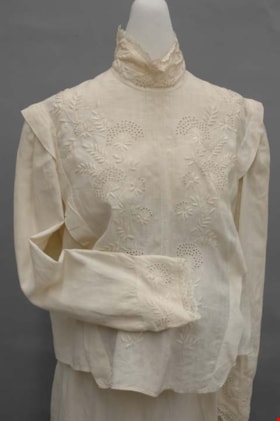
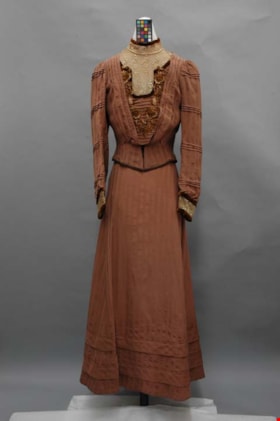
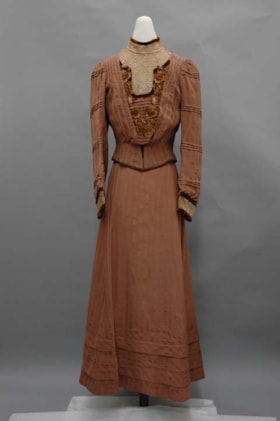
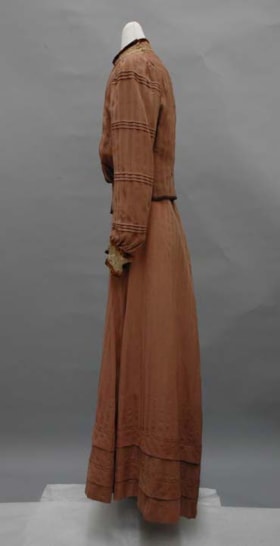
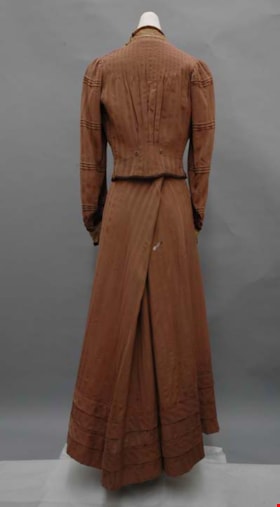
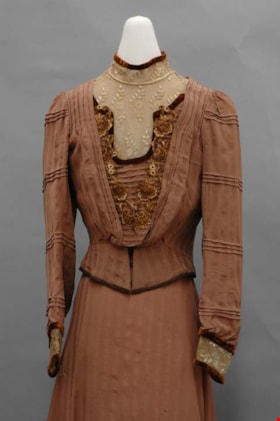
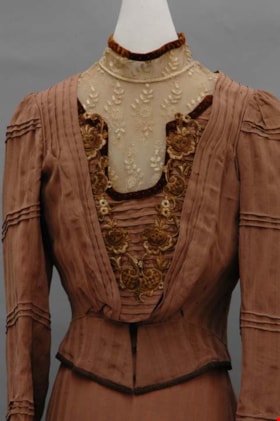
.jpg?width=280)
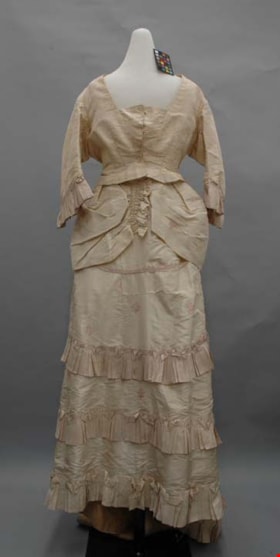
.jpg?width=280)
